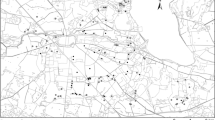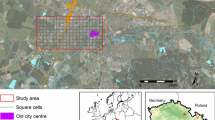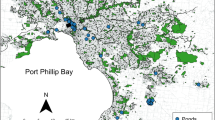Abstract
Management recommendations that target urban invaders should consider environmental and socio-economic aspects peculiar to the urban landscape. Urbanization often leads to the fragmentation of the invaded landscape into subunits inaccessible to managers (restricted access) or for which detailed information is lacking. Using models to explore impact of these limitations on management success provides a useful approach to propose effective countermeasures. Here we deploy a spatially explicit age-structured model applied to a pond network to investigate how restricted access and lack of detailed information may affect management of three invasive anuran species across a peri-urban landscape. The target species, the guttural toad Sclerophrys gutturalis, the African clawed frog Xenopus laevis and the painted reed frog Hyperolius marmoratus, belong to different ecotypes (terrestrial, aquatic and arboreal, respectively) and have different life history traits. We show that restricted property access significantly constrains management success in two of the three species (the guttural toad and the painted reed frog), while lack of detailed information around the invaded landscape impedes successful management in only one species (the guttural toad). The species-dependent response we detected is due to contrasting demographic and spatial invasion dynamics linked to the different anuran ecotypes. Our work highlights the necessity to adopt a context-dependent approach when proposing management recommendations in urban environment.


Similar content being viewed by others
References
Baker C, Bode M (2016) Placing invasive species management in a spatiotemporal context. Ecol Appl 26:712–725. http://onlinelibrary.wiley.com/doi/10.1890/15-0095/full
Beard KH, Price EA, Pitt W (2009) Biology and Impacts of Pacific Island Invasive Species. 5. Eleutherodactylus coqui, the Coqui Frog (Anura: Leptodactylidae) 1. Pac Sci 63:297–316
Beaty LE, Salice CJ (2013) Size matters: insights from an allometric approach to evaluate control methods for invasive Australian Rhinella marina. Ecol Appl 23:1544–1553. doi:10.1890/12-1298.1
Biek R, Funk WC, Maxell BA, Mills LS (2002) What is missing in amphibian decline research: insights from ecological sensitivity analysis. Conserv Biol 16:728–734
Bishop PJ (2004) Hyperolius marmoratus Rapp, 1842. In: Minter LR, Burger M, Harrison JA, Braack HH, Bishop PJ, Kloepfer D (eds) Atlas and red data book of the frogs of South Africa, Lesotho and Swaziland. Smithsonian Institution, Washington, D.C., pp 141–143
Blaustein AR, Hoffman PD, Hokit DG, Kiesecker JM, Walls SC, Hays JB (1994) UV repair and resistance to solar UV-B in amphibian eggs: a link to population declines? Proc Natl Acad Sci 91:1791–1795
Blossey B (1999) Before, during and after: the need for long-term monitoring in invasive plant species management. Biol Invasions 1:301–311. doi:10.1023/A:1010084724526
Bogich TL, Liebhold AM, Shea K (2008) To sample or eradicate? A cost minimization model for monitoring and managing an invasive species. J Appl Ecol 45:1134–1142. doi:10.1111/j.1365-2664.2008.01494.x
Botham MS, Rothery P, Hulme PE, Hill MO, Preston CD, Roy DB (2009) Do urban areas act as foci for the spread of alien plant species? An assessment of temporal trends in the UK. Divers Distrib 15:338–345. doi:10.1111/j.1472-4642.2008.00539.x
Bousquet F, Le Page C (2004) Multi-agent simulations and ecosystem management: a review. Ecol modell 176:313–332. doi:10.1016/j.ecolmodel.2004.01.011
Caplat P, Coutts S, Buckley YM (2012) Modeling population dynamics, landscape structure, and management decisions for controlling the spread of invasive plants. Ann NY Acad Sci 1249:72–83. doi:10.1111/j.1749-6632.2011.06313.x
Carrasco LR, Cook D, Baker R, MacLeod A, Knight JD, Mumford JD (2012) Towards the integration of spread and economic impacts of biological invasions in a landscape of learning and imitating agents. Ecol Econ 76:95–103. doi:10.1016/j.ecolecon.2012.02.009
Chadès I, Martin TG, Nicol S, Burgman M, Possingham HP, Buckley YM (2011) General rules for managing and surveying networks of pests, diseases, and endangered species. Proc Natl Acad Sci 108:8323–8328. doi:10.1073/pnas.1016846108
Coutts SR, van Klinken RD, Yokomizo H, Buckley YM (2011) What are the key drivers of spread in invasive plants: dispersal, demography or landscape: and how can we use this knowledge to aid management? Biol Invasions 13:1649–1661. doi:10.1007/s10530-010-9922-5
Cuddington K, Fortin MJ, Gerber LR, Hastings A, Liebhold A, O’Connor M, Ray C (2013) Process-based models are required to manage ecological systems in a changing world. Ecosphere 4:1–12. doi:10.1890/ES12-00178.1
Davies SJ, Clusella-Trullas S, Hui C, McGeoch MA (2013) Farm dams facilitate amphibian invasion: extra-limital range expansion of the painted reed frog in South Africa. Austral Ecol 38:851–863
Davies SJ, Measey GJ, Du Plessis D, Richardson DM (2016) Science and education at the Centre for Invasion Biology. In: Castro P, Azeiteiro UM, Bacelar-Nicolau P, Leal Filho W, Azul AM (eds) Biodiversity and education for sustainable development, World Sustainability Series. Springer, Cham, pp 93–105
De Villiers A (2006) Amphibia: anura: Bufonidae Bufo gutturalis Power, 1927 guttural toad introduced population. Afr Herp News 40:28–30
De Villiers FA (2016) The dispersal ability, performance and population dynamics of Cape Xenopus frogs. MSc thesis, Stellenbosch University
Dehnen-Schmutz K, Touza J, Perrings C, Williamson M (2007) A century of the ornamental plant trade and its impact on invasion success. Divers Distrib 13:527–534. doi:10.1111/j.1472-4642.2007.00359.x
Dickinson JL, Zuckerberg B, Bonter DN (2010) Citizen science as an ecological research tool: challenges and benefits. Annu Rev Ecol Evol Syst 41:149–172
Epanchin-Niell RS, Liebhold AM (2015) Benefits of invasion prevention: effect of time lags, spread rates, and damage persistence. Ecol Econ 116:146–153. doi:10.1016/j.ecolecon.2015.04.014
Epanchin-Niell RS, Haight RG, Berec L, Kean JM, Liebhold AM (2012) Optimal surveillance and eradication of invasive species in heterogeneous landscapes. Ecol Lett 15:803–812. doi:10.1111/j.1461-0248.2012.01800.x
Epanchin-Niell RS, Brockerhoff EG, Kean JM, Turner JA (2014) Designing cost-efficient surveillance for early detection and control of multiple biological invaders. Ecol Appl 24:1258–1274. doi:10.1890/13-1331.1
Facon B, David P (2006) Metapopulation dynamics and biological invasions: a spatially explicit model applied to a freshwater snail. Am Nat 168:769–783. doi:10.1086/508669
Feng YJ, Blackburn DC, Liang D, Hillis DM, Wake DB, Cannatella DC, Zhang P (2017) Phylogenomics reveals rapid, simultaneous diversification of three major clades of Gondwanan frogs at the Cretaceous-Paleogene boundary. Proc Natl Acad Sci 114:5864–5870. doi:10.1073/pnas.1704632114
Finnoff D, Shogren JF, Leung B, Lodge D (2005) The importance of bioeconomic feedback in invasive species management. Ecol Econ 52:367–381. doi:10.1016/j.ecolecon.2004.06.020
Florance D, Webb JK, Dempster T, Kearney MR, Worthing A, Letnic M (2011) Excluding access to invasion hubs can contain the spread of an invasive vertebrate. Proc R Soc Lond Ser B 278:2900–2908. doi:10.1098/rspb.2011.0032
Foster J, Sandberg LA (2004) Friends or foe? Invasive species and public green space in Toronto. Geogr Rev 94:178–198. doi:10.1111/j.1931-0846.2004.tb00166.x
Fuller RA, Irvine KN, Devine-Wright P, Warren PH, Gaston KJ (2007) Psychological benefits of greenspace increase with biodiversity. Biol Lett 3:390–394. doi:10.1098/rsbl.2007.0149
Furman BL, Bewick AJ, Harrison TL, Greenbaum E, Gvoždík V, Kusamba C, Evans BJ (2015) Pan-African phylogeography of a model organism, the African clawed frog ‘Xenopus laevis’. Mol Ecol 24:909–925
Gaertner M, Larson BMH, Irlich UM, Holmes PM, Stafford L, van Wilgen BW, Richardson DM (2016) Managing invasive species in cities: a framework from Cape Town, South Africa? Landsc Urban Plann 151:1–9. doi:10.1016/j.landurbplan.2016.03.010
Harvey CT, Qureshi SA, MacIsaac HJ (2009) Detection of a colonizing, aquatic, non-indigenous species. Divers Distrib 15:429–437
Holden M, Nyrop J, Ellner S (2016) The economic benefit of time‐varying surveillance effort for invasive species management. J Appl Ecol 53:712–721. http://onlinelibrary.wiley.com/doi/10.1111/1365-2664.12617/pdf
Hui C, Richardson DM (2017) Invasion dynamics. Oxford University Press, Oxford
Hulme PE (2006) Beyond control: wider implications for the management of biological invasions. J Appl Ecol 43:835–847. doi:10.1111/j.1365-2664.2006.01227.x
Hulme PE (2014) Invasive species challenge the global response to emerging diseases. Trends Parasitol 30:267–270. doi:10.1016/j.pt.2014.03.005
Januchowski-Hartley SR, Visconti P, Pressey RL (2011) A systematic approach for prioritizing multiple management actions for invasive species. Biol Invasions 13:1241–1253. doi:10.1007/s10530-011-9960-7
Joly P, Miaud C, Lehmann A, Grolet O (2001) Habitat matrix effects on pond occupancy in newts. Conserv Biol 15:239–248
Juliano SA, Lounibos LP (2005) Ecology of invasive mosquitoes: effects on resident species and on human health. Ecol Lett 8:558–574. doi:10.1111/j.1461-0248.2005.00755.x
Kettenring KM, Adams CR (2011) Lessons learned from invasive plant control experiments: a systematic review and meta-analysis. J Appl Ecol 48:970–979. doi:10.1111/j.1365-2664.2011.01979.x
Kohli RK, Batish DR, Singh HP, Dogra KS (2006) Status, invasiveness and environmental threats of three tropical American invasive weeds (Parthenium hysterophorus L., Ageratum conyzoides L., Lantana camara L.) in India. Biol Invasions 8:1501–1510. doi:10.1007/s10530-005-5842-1
Lampo M, De Leo G (1998) The invasion ecology of the toad Bufo marinus: from South America to Australia. Ecol Appl 8:388–396
Lever C (2001) The cane toad: the history and ecology of a successful colonist. Westbury Academic & Scientific Pub, Otley
Lockwood JL, Cassey P, Blackburn T (2005) The role of propagule pressure in explaining species invasions. Trends Ecol Evol 20:223–228. doi:10.1016/j.tree.2005.02.004
Mackenzie BF, Larson BMH (2010) Participation under time constraints: landowner perceptions of rapid response to the emerald ash borer. Soc Nat Resour 23:1013–1022. doi:10.1080/08941920903339707
Marchante E, Marchante H, Morais M, Freitas H (2010) Combining methodologies to increase public awareness about invasive alien plants in Portugal. In: 2nd International workshop on invasive plants in the mediterranean type regions of the world. European Environment Agency, Trabzon, pp 227–239
Measey J (2016) Overland movement in African clawed frogs (Xenopus laevis): a systematic systematic review. PeerJ 4:e2474
Measey GJ, Tinsley RC (1998) Feral Xenopus laevis in South Wales. Herpetol J 8:23–27
Measey GJ, Rödder D, Green SL, Kobayashi R, Lillo F, Lobos G, Thirion JM (2012) Ongoing invasions of the African clawed frog, Xenopus laevis: a global review. Biol Invasions 14:2255–2270
Measey GJ, Vimercati G, Villiers FA, Mokhatla M, Davies SJ, Thorp CJ, Kumschick S (2016) A global assessment of alien amphibian impacts in a formal framework. Divers Distrib 22:970–981
Measey J, Davies S, Vimercati G, Rebelo A, Schmidt W, Turner AA (2017) Invasive amphibians in southern Africa: a review of invasion pathways. Bothalia Appl Biodivers Conserv 47:1–12. doi:10.4102/abc.v47i2.2117
Mehta SV, Haight RG, Homans FR, Polasky S, Venette RC (2007) Optimal detection and control strategies for invasive species management. Ecol Econ 61:237–245. doi:10.1016/j.ecolecon.2006.10.024
Moen DS, Irschick DJ, Wiens JJ (2013) Evolutionary conservatism and convergence both lead to striking similarity in ecology, morphology and performance across continents in frogs. Proc R Soc B 280(1773):20132156
Moore JL, Runge MC, Webber BL, Wilson JRU (2011) Contain or eradicate? Optimizing the management goal for Australian acacia invasions in the face of uncertainty. Divers Distrib 17:1047–1059. doi:10.1111/j.1472-4642.2011.00809.x
Morris JA, Shertzer KW, Rice JA (2010) A stage-based matrix population model of invasive lionfish with implications for control. Biol Invasions 13:7–12. doi:10.1007/s10530-010-9786-8
Müllerová J, Pyšek P, Jarošík V, Pergl JAN (2005) Aerial photographs as a tool for assessing the regional dynamics of the invasive plant species Heracleum mantegazzianum. J Appl Ecol 42:1042–1053
Myers JH, Simberloff D, Kuris AM, Carey JR (2000) Eradication revisited: dealing with exotic species. Trends Ecol Evol 15:316–320. doi:10.1016/S0169-5347(00)01914-5
Novoa A, Dehnen-Schmutz K, Fried J, Vimercati G (2017) Does public awareness increase support for invasive species management? Promising evidence across taxa and landscape types. Biol Invasions. doi:10.1007/s10530-017-1592-0
Olson LJ (2006) The economics of terrestrial invasive species: a review of the literature. Agric Resour Econ Rev 35:178–194. http://ageconsearch.umn.edu/bitstream/10181/1/35010178.pdf
Olson LJ, Roy S (2005) On prevention and control of an uncertain biological invasion. Rev Agric Econ 27:491–497. doi:10.1111/j.1467-9353.2005.00249.x
Panetta FD (2007) Evaluation of weed eradication programs: containment and extirpation. Divers Distrib 13:33–41. doi:10.1111/j.1472-4642.2006.00294.x
Panetta FD, Cacho OJ (2014) Designing weed containment strategies: an approach based on feasibilities of eradication and containment. Divers Distrib 20:555–566. doi:10.1111/ddi.12170
Pichancourt JB, Chadès I, Firn J, van Klinken RD, Martin TG (2012) Simple rules to contain an invasive species with a complex life-cycle and high dispersal capacity. J Appl Ecol 49:52–62. doi:10.1111/j.1365-2664.2011.02093.x
Picker MD, de Villiers AL (1989) The distribution and conservation status of Xenopus gilli (Anura: Pipidae). Biol Conserv 49:169–183
Pluess T, Cannon R, Jarošík V, Pergl J, Pyšek P, Bacher S (2012) When are eradication campaigns successful? A test of common assumptions. Biol Invasions 14:1365–1378. doi:10.1007/s10530-011-0160-2
Pyšek P, Hulme PE (2005) Spatio-temporal dynamics of plant invasions: Linking pattern to process 1. Biol Invasions 12:302–315. doi:10.2980/i1195-6860-12-3-302.1
Pyšek P, Richardson DM (2010) Invasive species, environmental change, and health. Annu Rev Environ Resour 35:25–55. doi:10.1146/annurev-environ-033009-095548
Ramula S, Knight TM, Burns JH, Buckley YM (2008) General guidelines for invasive plant management based on comparative demography of invasive and native plant populations. J Appl Ecol 45:1124–1133. doi:10.1111/j.1365-2664.2008.01502.x
Reis CS, Marchante H, Freitas H, Marchante E (2013) Public perception of invasive plant species: assessing the impact of workshop activities to promote young students’ awareness. Int J Sci Educ 35:690–712
Rowe L, Ludwig D (1991) Size and timing of metamorphosis in complex life cycles: time constraints and variation. Ecology 72:413–427
Shea K, Sheppard A, Woodburn T (2006) Seasonal life-history models for the integrated management of the invasive weed nodding thistle Carduus nutans in Australia. J Appl Ecol 43:517–526. doi:10.1111/j.1365-2664.2006.01160.x
Silvertown J, Harvey M, Greenwood R, Dodd M, Rosewell J, Rebelo T (2015) Crowdsourcing the identification of organisms: a case-study of iSpot. ZooKeys 480:125–146
Simberloff D (2003) Eradication—preventing invasions at the outset. Weed Sci 51:247–253. doi:10.1614/0043-1745(2003)051[0247:EPIATO]2.0.CO;2
Simberloff D, Gibbons L (2004) Now you see them, now you don’t!—Population crashes of established introduced species. Biol Invasions 6:161–172. doi:10.1023/B:BINV.0000022133.49752.46
Simberloff D, Martin JL, Genovesi P, Maris V, Wardle DA, Aronson J, Vilà M (2013) Impacts of biological invasions: what’s what and the way forward. Trends Ecol Evol 28:58–66. doi:10.1016/j.tree.2012.07.013
Smith MA, Green DM (2005) Dispersal and the metapopulation in amphibian and paradigm ecology are all amphibian conservation: populations metapopulations? Ecography 28:110–128. doi:10.1111/j.0906-7590.2005.04042.x
Smith MA, Green DM (2006) Sex, isolation and fidelity: unbiased long-distance dispersal in a terrestrial amphibian. Ecography 29:649–658. doi:10.1111/j.2006.0906-7590.04584.x
Steel J, Weiss J, Morfe T (2014) To weed or not to weed? The application of an agent-based model to determine the costs and benefits of different management strategies. Plant Prot Q 29:101–110
Tingley R, Ward-Fear G, Schwarzkopf L, Greenlees MJ, Phillips BL, Brown G, Clulow S, Webb J, Capon R, Strive T (2017) New weapons in the toad toolkit: a review of methods to control and mitigate the biodiversity impacts of invasive cane toads (Rhinella Marina). Q Rev Biol 92:123–149. doi:10.1086/692167
Tittensor DP, Walpole M, Hill SLL, Boyce DG, Britten GL, Burgess ND, Ye Y (2014) A mid-term analysis of progress toward international biodiversity targets. Science 346(6206):241–244. doi:10.1126/science.1257484
Van Sittert L, Measey GJ (2016) Historical perspectives on global exports and research of African clawed frogs (Xenopus laevis). Trans R Soc S Afr 71:157–166
Van Wilgen BW, Scott DF (2001) Managing fires on the Cape Peninsula, South Africa: dealing with the inevitable. J Mediterr Ecol 2:197–208
Van Wilgen BW, Davies SJ, Richardson DM (2014) Invasion science for society: a decade of contributions from the centre for invasion biology. S Afr J Sci 110:1–12. doi:10.1590/sajs.2014/a0074
Verbrugge LNH, Van Den Born RJG, Lenders HJR (2013) Exploring public perception of non-native species from a visions of nature perspective. Environ Manag 52:1562–1573. doi:10.1007/s00267-013-0170-1
Vidal-García M, Keogh JS (2015) Convergent evolution across the Australian continent: ecotype diversification drives morphological convergence in two distantly related clades of Australian frogs. J Evol Biol 28:2136–2151. doi:10.1111/jeb.12746
Vilà M, Basnou C, Pyšek P, Josefsson M, Genovesi P, Gollash S et al (2009) How well do we understand the impacts of alien species on ecosystem services? A pan-European, cross-taxa assessment. Front Ecol Environ 8:135–144. doi:10.1890/080083
Vimercati G (2017) Exploring the invasion of the guttural toad Sclerophrys gutturalis in Cape Town through a multidisciplinary approach. Ph.D. Dissertation, Stellenbosch University
Vimercati G, Hui C, Davies SJ, Measey GJ (2017) Integrating age structured and landscape resistance models to disentangle invasion dynamics of a pond-breeding anuran. Ecol Modell 356:104–116. doi:10.1016/j.ecolmodel.2017.03.017
Vonesh JR, De la Cruz O (2002) Complex life-cycles and density dependence: assessing the contribution of egg mortality to amphibian declines. Oecol 133:325–333. doi:10.1007/s00442-002-1039-9
Vos CC, ter Braak CJF, Nieuwenhuizen W (2000) Incidence function modelling and conservation of the tree frog Hyla arborea in the Netherlands. Ecol Bull 48:165–180
Warren CR (2007) Perspectives on the `alien’ versus `native’ species debate: a critique of concepts, language and practice. Prog Hum Geogr 31:427–446. doi:10.1177/0309132507079499
Werner EE, Gilliam JF (1984) The ontogenetic niche and species interactions in size-structured populations. Annu Rev Ecol Syst 15:393–425
With KA (2004) Assessing the risk of invasive spread in fragmented landscapes. Risk Anal 24:803–815. doi:10.1111/j.0272-4332.2004.00480.x
Withers P, Louw G, Nicolson S (1982) Water loss, oxygen consumption and colour change in ‘waterproof’ reed frogs (Hyperolius). S Afr J Sci 78:30–32
Wood KA, Stillman RA, Goss-Custard JD (2015) Co-creation of individual-based models by practitioners and modellers to inform environmental decision-making. J Appl Ecol 52:810–815. doi:10.1111/1365-2664.12419
Acknowledgements
Funding was provided by the DST-NRF Centre of Excellence for Invasion Biology.
Author information
Authors and Affiliations
Corresponding author
Additional information
Guest Editors: Mirijam Gaertner, John R.U. Wilson, Marc W. Cadotte, J. Scott MacIvor, Rafael D. Zenni and David M. Richardson/Urban Invasions.
Electronic supplementary material
Below is the link to the electronic supplementary material.
Rights and permissions
About this article
Cite this article
Vimercati, G., Davies, S.J., Hui, C. et al. Does restricted access limit management of invasive urban frogs?. Biol Invasions 19, 3659–3674 (2017). https://doi.org/10.1007/s10530-017-1599-6
Received:
Accepted:
Published:
Issue Date:
DOI: https://doi.org/10.1007/s10530-017-1599-6




